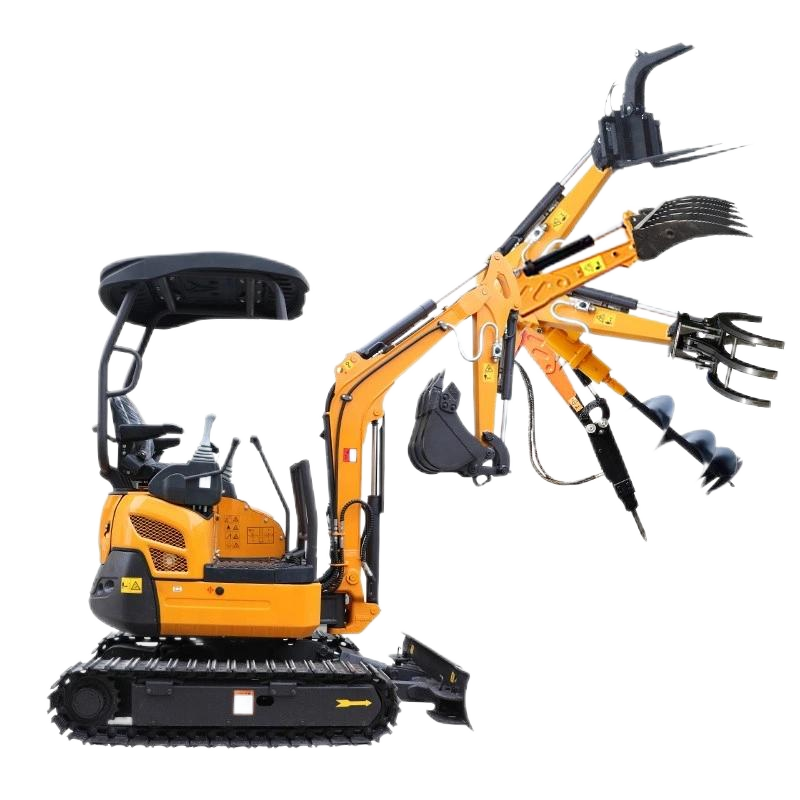Micro excavators (also known as mini excavators) are compact construction machines designed for small-scale projects where space is limited. Here is a detailed overview of their functions, applications, and advantages:

- Core Functions and Uses of Micro Excavators
Precision Digging: Ideal for tasks that require delicate excavation, such as trenching for utilities (e.g., pipes, cables), landscaping, or backyard projects.
Demolition and Recycling: Efficiently handle small-scale demolition, breaking up concrete or structures in confined areas (e.g., urban renovations).
Material Handling: Equipped with buckets or attachments to lift and move debris, soil, or gravel in tight spaces.
Versatility: Adaptable to various terrains, including gardens, indoor sites, and narrow urban streets where larger equipment cannot access. - Main Types of Micro Excavators
By Power Source:
Diesel-Powered: The traditional choice for higher torque and longer runtime, suitable for outdoor projects.
Electric/Battery-Powered: Emerging models with zero emissions, low noise, and suitability for indoor or environmentally sensitive areas (e.g., urban construction).
By Mobility:
Tracked Micro Excavators: Provide stability on uneven or soft ground (e.g., mud, grass) and minimize ground damage.
Wheeled Micro Excavators: Offer faster movement on hard surfaces like roads or paved sites.
By Size:
Typically, they range from 0.8 to 3 tons in weight, and smaller models (below 1.5 tons) excel in extremely confined spaces. - Advantages of Micro Excavators
Maneuverability: The compact design allows access to narrow areas, such as alleys, basements, or residential yards.
Reduced Environmental Impact: Electric models emit no pollutants and produce less noise, making them highly suitable for urban or noise-sensitive environments.
Cost-Effective: Lower fuel/energy costs compared to larger excavators, and easier transportation due to the lightweight design.
Versatility: Can be fitted with various attachments (e.g., augers, crushers, grapples) to perform tasks beyond digging, such as drilling, demolition, or tree removal. - Typical Application Scenarios
Urban Construction: Utility repairs, sidewalk renovations, or small-scale building projects in crowded cities.
Landscaping: Digging ponds, planting trees, or grading gardens.
Agriculture and Forestry: Maintaining irrigation systems, clearing land, or working in orchards.
Indoor Projects: Demolition or excavation inside buildings (e.g., basement renovations). - Operation and Maintenance Tips
Safety First: Operators should receive training to handle the machine's controls and stability, especially on uneven terrain.
Regular Maintenance:
Check the hydraulic system, tracks (if applicable), and engine performance.
Clean debris from the machine and lubricate moving parts to ensure its longevity.
Attachment Care: Properly secure and inspect attachments to prevent accidents during use. - Technological Trends
Electric Innovation: Battery-powered micro excavators are becoming increasingly popular due to improved energy efficiency and reduced emissions.
Intelligentization: Some models integrate GPS tracking or remote monitoring for better fleet management.
Enhanced Efficiency: Design improvements, such as more powerful hydraulic systems, allow smaller machines to tackle heavier tasks.
Conclusion
Micro excavators are essential for small-scale, precision-driven projects where larger equipment cannot operate. Their compact size, versatility, and environmental benefits make them the preferred choice in urban environments, landscaping, and specialized industries. In 2025, advancements in electric and smart technologies are further expanding their capabilities, solidifying their role in sustainable and efficient construction.
Micro excavators are essential for small-scale, precision-driven projects where larger equipment cannot operate. Their compact size, versatility, and environmental benefits make them the preferred choice in urban environments, landscaping, and specialized industries. In 2025, advancements in electric and smart technologies are further expanding their capabilities, solidifying their role in sustainable and efficient construction.





